When visiting and exploring seagrass beds, most are hoping, and expecting, to see fish. As we have seen in this series, there are a lot of creatures that can be found living within a seagrass meadow, but it is the fish that get our attention and what we talk most about afterwards.
According to Hoese and Moore’s Fishes of the Gulf of Mexico; Texas, Louisiana, and Adjacent Waters, there are 497 species of fish found in the Gulf of Mexico. In my surveys of Pensacola Bay over the years, I have logged 101 of those in the estuary. I am sure there are more, but I can confirm there are at least those. Many spend all or part of their time in our seagrasses. As you seine or snorkel in the grassbeds you will notice most of them are very small. Much of this is due to the fact that the seagrasses are nursery areas for many species, and it is the young that we find here. But many are also small as adults, and the grass provides food and shelter for them. There are far too many to mention in an article like this, but let’s look at some of them.
Sardines and Anchovies
As you snorkel through the grass, or even look at it from a boat or dock, you see numerous silver colored baitfish flashing as they dart in and out of the grass. There are all sorts of silver baitfish in the seagrasses with sardines and anchovies being two of them. In my experience seining for fish, they appear to be seasonal. I did not capture them all year but when I did, I would capture a lot. These species are famous for being the ones in small tins that people consume, though there is no fishery for them here locally. Anchovies have also been considered an indicator species; their presence suggests good water quality.

Silverside Minnows
Also known as silversides and glass minnows, these are one of the most common fish collected in seine nets. They are abundant year-round and are an important food source for many of the larger predators living here. Small and transparent, you do not see them while snorkeling. Their huge presence is only discovered when you pull a seine net through the grass. There are several species of them, but they are not easily identified and more often are just logged as “silversides”. They are an important member of the seagrass community.

Seahorses and Pipefish
These two fish are highly specialized for living in seagrasses. They look like grass and move very little making them hard to detect. Like silverside minnows, it is rare to see them while snorkeling but make their presence known when seining. Their bodies are covered in armor-like scales, and they have tubed mouths for “vacuuming” small invertebrates from the water column. They are very slow swimmers and have to avoid detection by blending in with the environment. And yes, it is the males that carry the eggs in their brood pouches. These are amazing fish and always bring excitement when they are captured in the net. There are two species of seahorses and seven species of pipefish found in our waters.
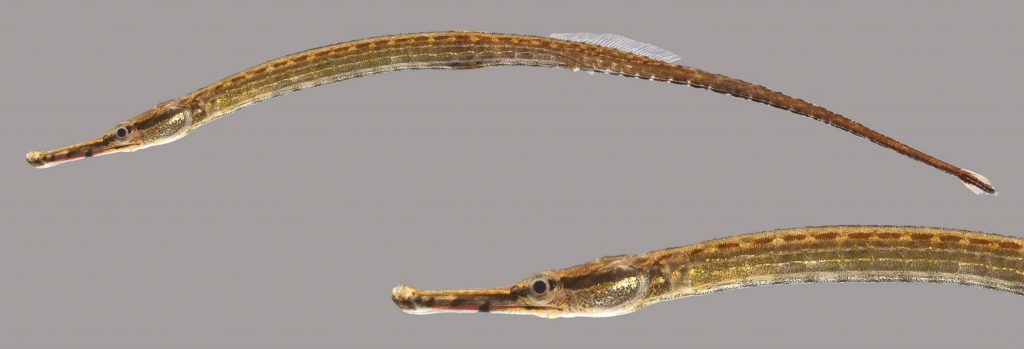
Killifish
Often called “bull minnows” by anglers, these small fish are, at times, very abundant. There are seven species of killifish in our bays but the Gulf Killifish, Longnose Killifish, and the Bayou Killifish are the ones we most often collected.
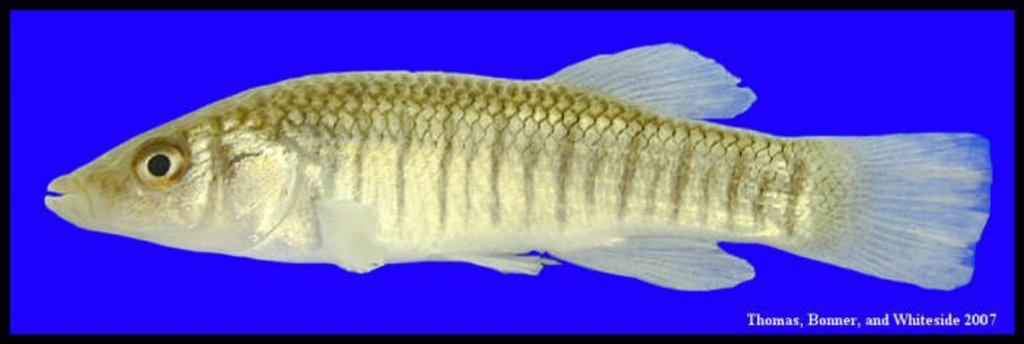
Needlefish
These are common, frequently seen, fish swimming at the surface of the water. Long and needle-shaped, these fish have long snouts full of sharp teeth indicating they are one of the predators of this system. There are four species of them, and they are not easy to tell apart. They are harmless to humans unless you capture them in your net at which time they will try to bite.
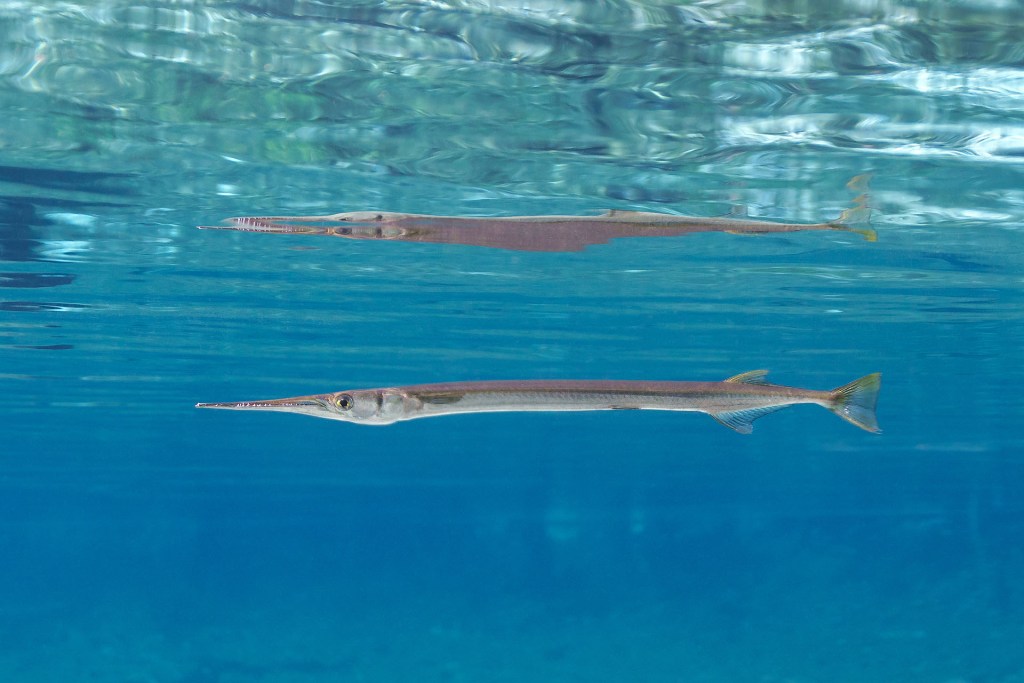
Mullet
Another very common fish found year-round here. This species are the ones famous for jumping while you are fishing, paddling, or just watching from the beach. Those who do not visit the Gulf coast often always ask “I just saw a fish jump!” and the reply from a local (without even looking up to see what it was) will reply “It’s a mullet”. These schooling fish can get pretty large (average length is 30 inches) and it is common to see fishermen out with their cast nets trying to catch a few. It is a popular food fish for those along the Gulf coast. Mullet fries, with beans and grits, are a way of life here. The fish are easily seen swimming and darting over the grass as you paddle by, and their young are found seasonally in seine nets. They are bottom feeders, feeding mostly on algae from the grass blades. There are actually two species, the white and the striped mullet. The striped mullet, also known as the black mullet, is the one most often sold in the seafood markets.

Drums and Croakers
With 18 species within this family, this is the largest family of inshore fish in the Gulf. Growing up along the panhandle people learn quickly about croakers. Back in the day when gill nets were used to harvest mullet, croakers were a common catch as well, and often consumed. Today they are still sought by some shore-based anglers and juveniles are common in seine nets. The species I most often captured were the spot and Atlantic croaker. Spot croakers were common year-round, Atlantic croakers were more seasonal.
Drums are larger members of this family. There are several species more associated with sandy bottoms and the shoreline of the Gulf, many of these are called whiting, but the red drum (redfish) and black drum can be found in the grassbeds. Redfish are particularly common here and one of the reasons many anglers get out of bed in the morning. They are very popular sportfish across the region. Black drums are not found as often, and like being around pilings and structures that offer certain foods they prefer. Both species can get quite large. Redfish average 5 feet while black drums can reach an average of 3 feet.
All of the fish in this family are famous for their “croaking” “drum” sounds they make using their swim bladder, and it is rare not to capture at least one kind in a seine net.
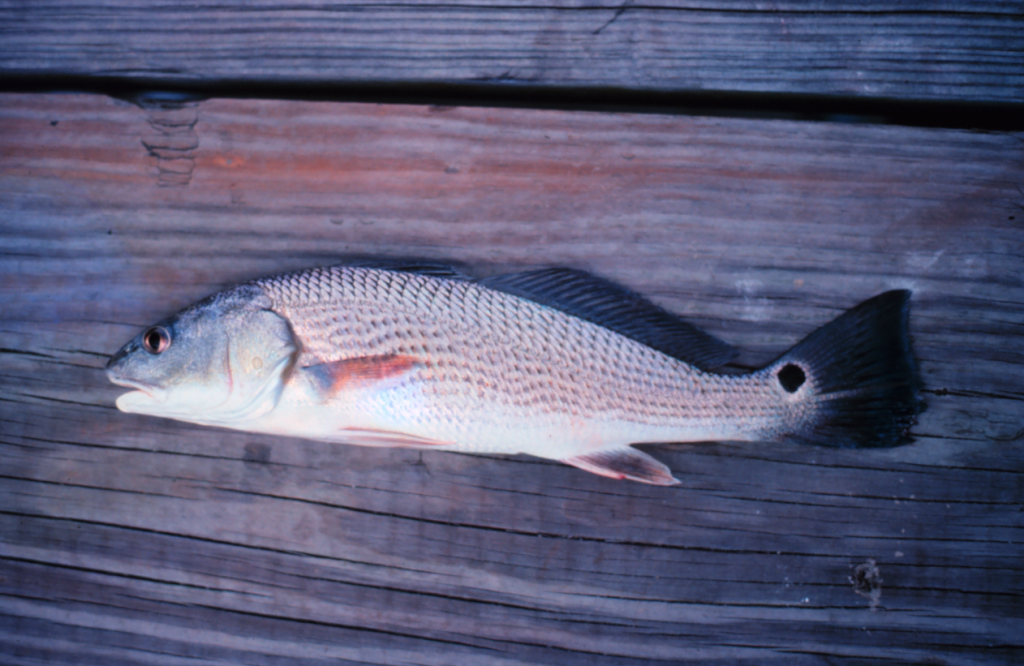
Spotted Seatrout; Speckled Trout; “Specks”
There is no “trout family” in the fish world. Most freshwater trout are members of the salmon family while the marine versions are members of the drum/croaker family. This is the case with the famous speckled trout – or speck. There are white trout and silver seatrout in this family, and all are sought after by anglers, but it is the speckled trout that is most associated with seagrasses, most sought after by anglers, and is one of the top predators in this system. They reach an average length of 4 feet.
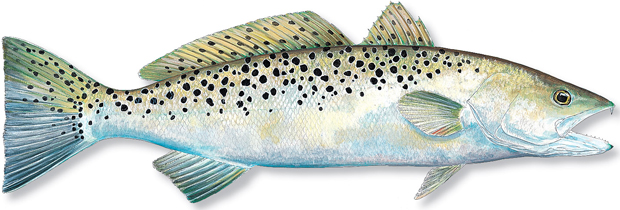
Pinfish and Sheepshead
From my experience both snorkeling and seining the grasses, I would say – hands down – that pinfish is the most common species found in our grasses. For many young anglers this is the first fish they ever catch. You can see them easily while snorkeling and they are the most numerous species in the nets throughout the year. Their huge numbers play an important role in the food web of this system. Feeding on a variety of small invertebrates in and around the grass blades, pinfish are a large part of the diet of the larger sportfish we target. Throwing cast nets and dropping pinfish traps is popular with anglers to collect this abundant baitfish for their life bait fishing efforts. They are called pinfish because of the sharp spines in their dorsal fins. These are also the fish that nip at your ankles while you are standing still in the water.
Sheepsheads are larger members of the porgy family (the ones these two species belong to). As adults sheepsheads prefer hard structure where they can use their incisors to chip away at barnacles and other shellfish, but they are sometimes found roaming the grassbeds and their young will spend their growing years hiding and feeding in the grass.
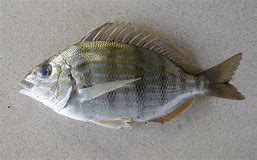
Pigfish
When first captured in the seine net, pigfish are often confused with pinfish – they look very similar. But a closer look at the striping/spotted pattern on their sides, and the position of their mouth, you realize you have something different. Being members of the grunt family, they also “croak” like croakers and drums – hence their common name “pigfish” – due to the grunting sounds. This helps with identifying which fish you have. Though common in the grasses, I did not catch these as frequently as pinfish and they were not as abundant.
Spotfin Mojarra
This is a common silver baitfish that resembles the pinfish and is frequently collected in our seine nets. The mojarra is in a different family than pinfish. They lack sharp spines and incisor teeth, rather they have a sort of “vacuum” like mouth which they use to suck small invertebrates from the sand.
Gag Grouper
This is a popular sport and commercial fish from the wrecks and reefs of the Gulf of Mexico. But gags begin their lives in the seagrass beds, and we have collected medium sized individuals in our seine nets. This underscores the importance of these grassbeds to the fisheries so many love. We need to protect these systems from our activity both on land and in the water.
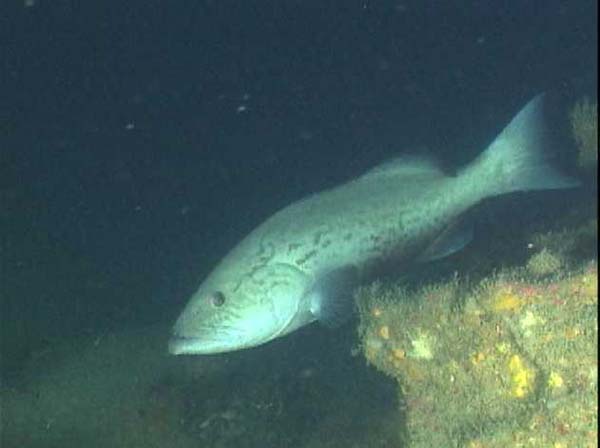
Jacks
Another popular group with anglers, many species of jacks use these grasses as their nurseries. We most often collected juvenile lookdowns, pompano, and crevalle in our nets. At times we caught a small member of the family called a leatherjacket. These were seasonal and associated with breeding. Once again, underscoring the importance of having healthy seagrasses.
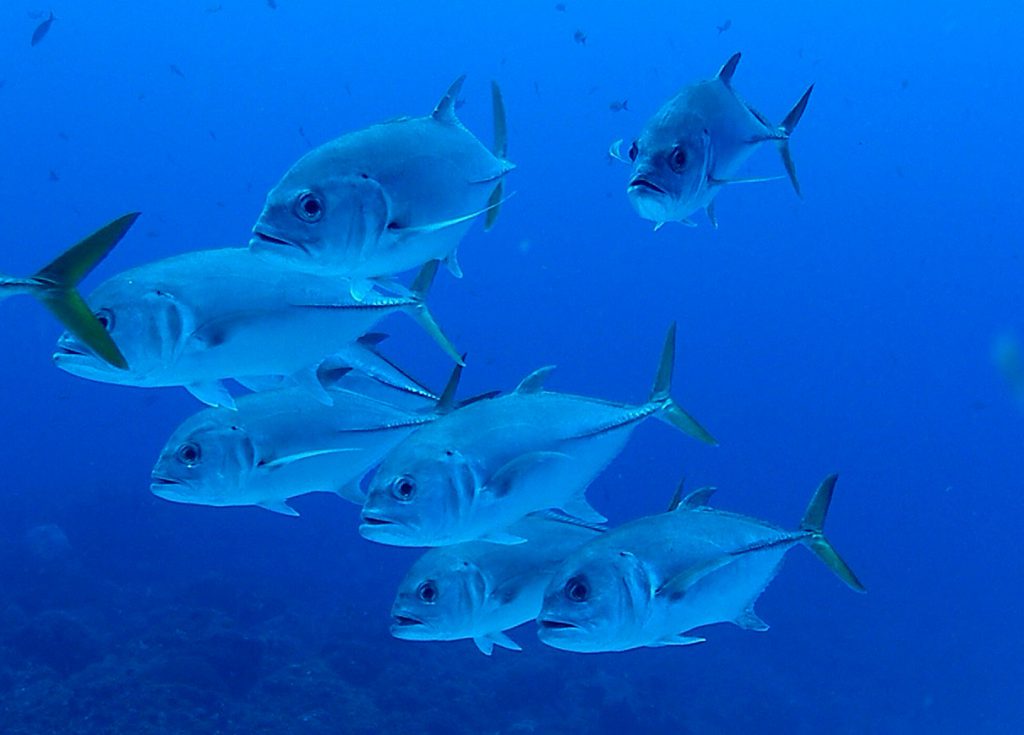
Toadfish
One of the creeper looking fish in the seagrass community is the Gulf toadfish (also known as the oyster dog). This monstrous looking bottom fish lives in burrows scattered around the grassbeds where they lie in wait to ambush prey. Their large mouths and sharp teeth can grab a variety of creatures, including the human finger. At times small toadfish will move into an empty can or bottle discarded by people instead of a burrow where they grow to a size they can no longer escape. It is said there may be a mild venom associated with their bite. Though no one has ever died, or been sent to the hospital, due their bite, it is painful and should be avoided.
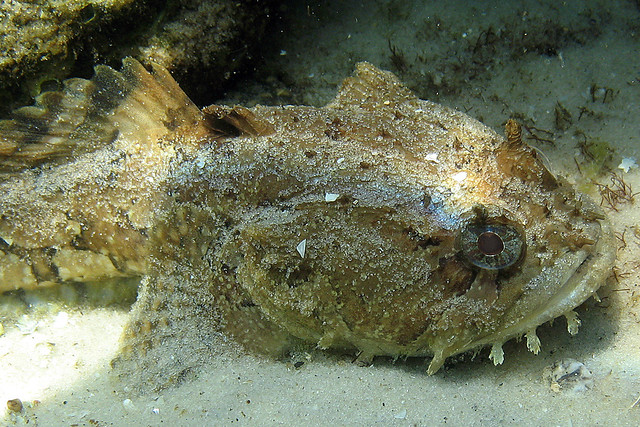
Barracuda
Yes, barracuda can be found in seagrasses. But in our case, these have all been juveniles. There are three species of them, and they are not easy to tell apart. They also appeared to be seasonal in our collections. We never found them high numbers, usually one or two in a seine. But they are present.
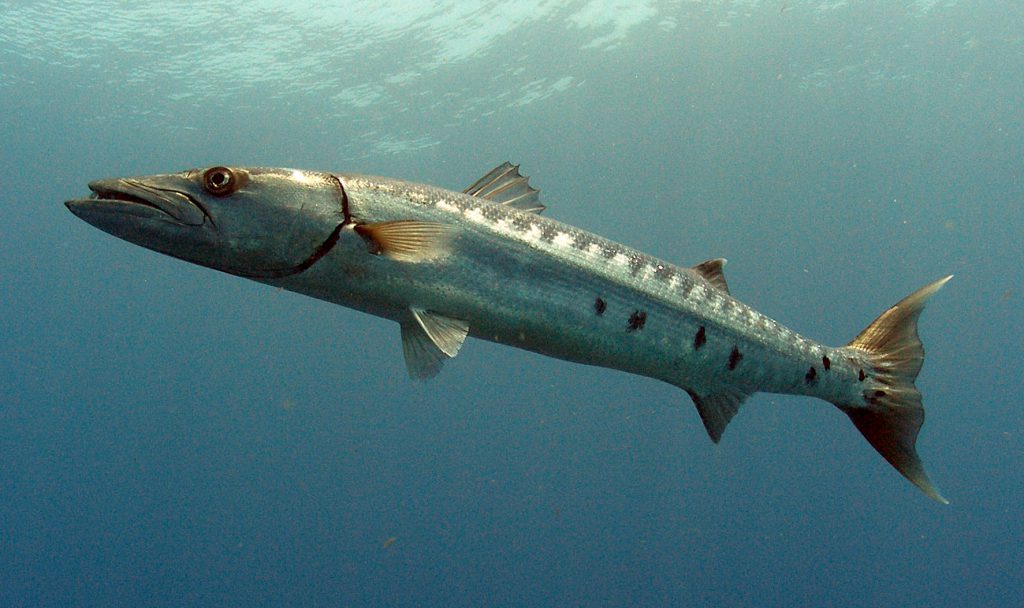
Lizardfish
This is another medium sized, sharp toothed, bottom dwelling predator of the grassbed community. There are seven species of them, and all have that “snake” “lizard” look to them having many sharp canine teeth. They spend their time buried in the sand waiting to ambush potential prey. Snorkelers may see them as they dart away tossing up sand when we get too close. I rarely see them snorkeling but occasionally capture them in the seine net to the delight of the students assisting.
Blennies and Gobies
These are very small fish that are almost impossible to find while snorkeling but are often collected in the seine net. They resemble the freshwater darters and, lacking a swim bladder, spend their time on the bottom. There are many species associated with rocks and artificial reefs but there are some who call the seagrasses home. They use their incisor teeth to feed on small invertebrates in and on the grasses. Being territorial, they can give a little nip to your hand. Gobies differ from blennies in that their two pelvic fins are fused together to form a sort of “cup” or “sucker disk”.
Puffers
Another one of the more popular fish with students who help me seine. Everyone loves to see them inflate with either water or air into a “balloon” to make it very difficult for predators to consume them. There are eight species of puffers in the Gulf of Mexico, five of them have been captured in our seines. Most are small with little “bumps” on their bodies instead of spines. But there is the Burrfish, who is a member of a different family that is medium sized, has spines, and is very common in the grassbeds.

Filefish
Our grassbeds are full of a small cousin to the triggerfish – the planehead filefish. Like triggerfish, filefish have a thick sharp spine that is found at the front of the dorsal fin – called a “trigger” on the triggerfish. The planehead filefish is a small species (nine inches average length), green to brown in color, and very common in the grassbeds; though you will probably not see one unless you catch it in a net.
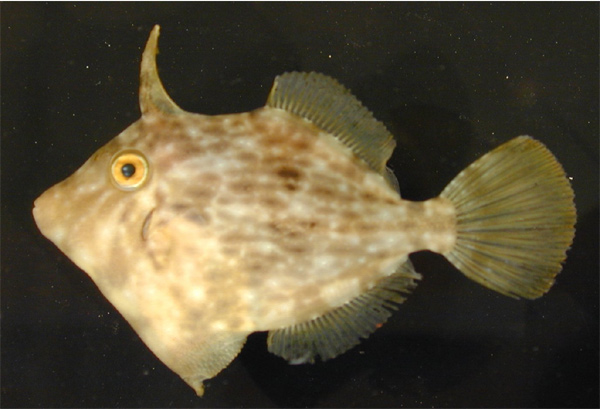
Flounders and Soles
A favorite food fish for many locals, flounders spend a lot of time buried in the sand near grassbeds to ambush prey. Born with a typical fish design, early in development one of their eyes will move to the other side of the head, giving them two eyes on one side. By doing this, they have increased their binocular vision, improving their ability to judge accurate distance of the prey, and making hunting easier. They lose color on the side where the eye has left and have chromatophores (cells) on the side where the eyes are that, like octopus and squid, allow them to change colors and blend in. In our part of the Gulf, if the eyes move to the left side of the head, they are called flounders. If they move to the right, they are called soles. Soles in our part of the Gulf of small not of much interest to anglers. One small species is often collected by shrimpers who feed them to hogs. This sole can “cup” their body in defense making like a suction cup and they do this in the throat of the hogs sometimes killing them. They are called “hogchokers”. Flounders on the other hand are very popular with anglers. Some fish for them using rod and reel, others prefer gigging them at night using lanterns. There are 17 species of flounder, some reaching lengths of three feet.
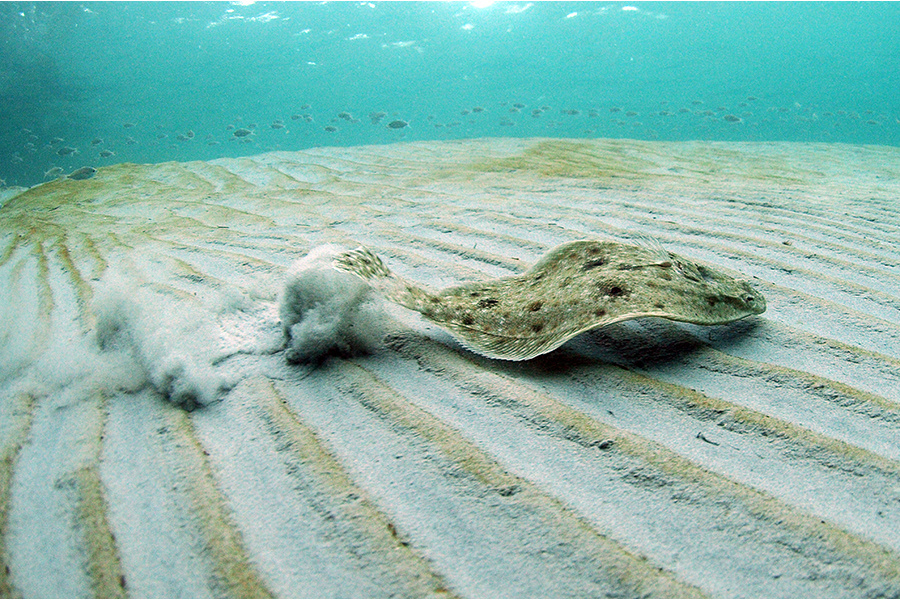
Tonguefish
Tonguefish are small flat fish with eyes on one side of their heads like flounder. They differ than that their tails come to a point and there is no caudal fin present, as there is in flounders. As mentioned, they are small – ranging from 3 to 8 inches in length. The Blackcheek tonguefish is particularly common in our grassbeds. But like so many, you will not see it unless you catch it in a net.
Snook
This is a very popular gamefish from south Florida associated with several habitats including grassbeds. Due to a process some call “tropicalization” – the movement of tropical species north due to climate change – snook are now, albeit in small numbers, reported in the Florida panhandle. This is a new species you may see while exploring or fishing out there.
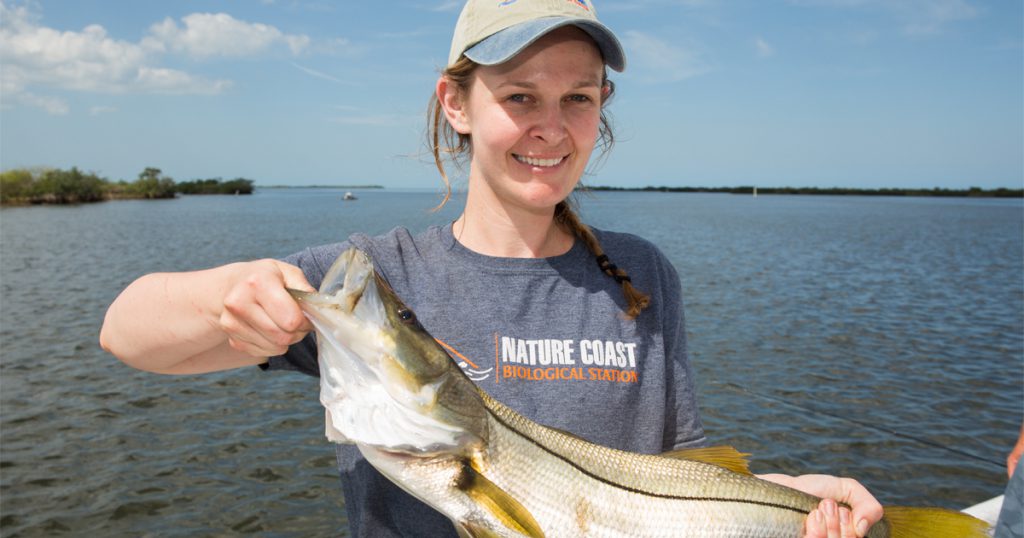
There are many more species of fish found in our grassbeds we could talk about, but we will end it here. As we mentioned in the beginning, this is a group of animals that many come to the beach to find. Whether for fun or for food, finding fish makes for a good day. See how many different species you can find.
- Rattlesnakes on Our Barrier Islands; Part 1 Knowing the Snake - December 8, 2025
- Tips for Bear Encounters this Fall - November 10, 2025
- Pensacola Bay Invasive Species Summer Survey 2025 - November 3, 2025
